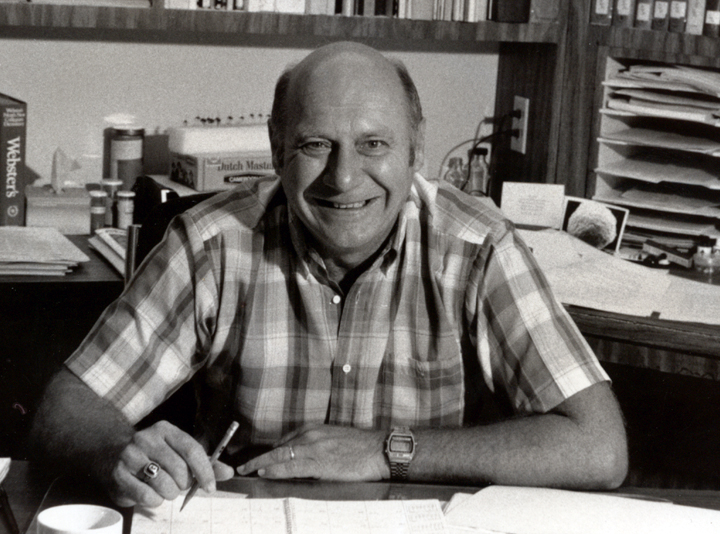Clayton (Clay) William McCoy Jr., 75, of Winter Park, Florida, passed away October 4th, 2013, in Orlando, Florida. He was born in Rochester, Minnesota, on June 22nd, 1938, and grew up on the family farm in Fairfax, Minnesota. He received a BS degree from Gustavus Adolphus College in 1960, an M.A. in Entomology from the University of Nebraska in 1963, and a Ph.D. in Entomology from the University of California at Riverside in 1967.
Clay joined the Society for Invertebrate Pathology in 1970 as a full member and retained membership for more than three decades. He was among a very close group of graduate school classmates at UC Riverside in the sixties that included Pat Vail, Charles Reichelderfer, Ken Hunter, and others, all of whom made major contributions to the fields of insect pathology and insect microbial control.
After graduating from UC Riverside, Clay moved to the USDA citrus laboratory in central Florida and initiated his research on the citrus rust mite. After five years at the USDA, Clay began a long and successful career as a faculty researcher at the University of Florida Institute of Food & Agricultural Sciences’ Citrus Research & Education Center (CREC) in Lake Alfred, Florida. He was the first recipient of the University of Florida’s CREC’s Distinguished Professorship in Research and Education. Clay retired from this position in 2005 after a 33-year career in research and education. Clay’s special areas of focus were integrated pest management (IPM) and the biological control of citrus pests.
His initial research program in Florida was directed at managing the citrus rust mite within a developing citrus IPM program. In concert with researchers at Abbott Laboratories, with lab director Terry Couch, Clay pioneered the development of Mycar, the first commercial mycopathogen registered for use in the U.S. against arthropod hosts. Clay’s research program on Mycar involved studies that addressed fungal nutrition, biphasic production and formulation of inoculum, and application technologies and strategies.
Clay received numerous awards and recognition in his career, including a United States Patent in 1994 for a bio-pesticide derived from a fungus and a USDA Honor Award (the agency’s highest recognition for outstanding contributions to agriculture). During this period, Clay developed ties with insect pathologists, acarologists and biocontrol and citriculture scientists on a global scale. In addition to the microbial control aspects, basic research on the fungus led to a systematic analysis of Hirsutella thompsonii biology and the discovery of the ribotoxin hirsutellin A.
In addition to his landmark achievements in the study of entomopathogenic fungi, Clay also made notable contributions to the field of entomopathogenic nematology. Specifically, he contributed substantial original research to the control of the Diaprepes root weevil – a significant and costly pest of citrus. He served as the coordinator the Diaprepes Task force for a number of years – serving the community of citrus growers, researchers, and students.
Clay was instrumental in developing methods for using entomopathogenic nematodes (particularly Steinernema riobrave) to control Diaprepes on a commercial level. Clay’s research focused on optimization of application parameters (such as rates, equipment, and formulation). Furthermore, impacting a broader ecological scope, he elucidated the effects of soil type and interactions between nematodes and other soil-dwelling organisms in the citrus system. The outcome was clearly one of the greatest success stories for using nematodes as biocontrol agents. His work still serves as the basis for Diaprepes pest management today.
During his scientific career, Clay authored or co-authored more than 200 scientific papers, book chapters, and books. In addition to his contributions to the Society for Invertebrate Pathology (SIP), Clay was an active member of the Entomological Society of America and the Florida Entomological Society, for which he served as president in 1984. He served as a co-organizer of the 1987 SIP meeting in Gainesville, Florida, and for many years, he served as host and local arrangements chair for S-135 and its subsequent iterations in Orlando.
Clay’s research and teaching took him to all corners of the globe, whether to present at scientific conferences or to provide consultation to citrus growers and government institutions. However, he felt the most gratifying aspect of his career was his interaction with his colleagues, post-doctoral fellows, graduate students, and research staff.
In his retirement, Clay co-authored the book Pathogens Infecting Insects & Mites of Citrus with colleagues Robert A. Samson, Drion G. Boucias, Lance S. Osborne, Jorge E. Peña, and Lyle J. Buss. He also demonstrated his love for the University of Florida Gators, rarely missing a football or basketball game, and he especially enjoyed walks with his dogs.
The balance of his retirement involved traveling and spending time with family and friends. On August 24th, just six weeks prior to his death, Clay and his wife Lynne celebrated their 50th wedding anniversary with family and friends who came from all over the U.S. and the world to celebrate with them. His friends and colleagues will miss his generosity, kindness, and omnipresent smile.
In lieu of flowers, the family is requesting that donations be made to the Parkinson’s Disease Foundation.
This memorial was prepared by Dr. Drion G. Boucias.
